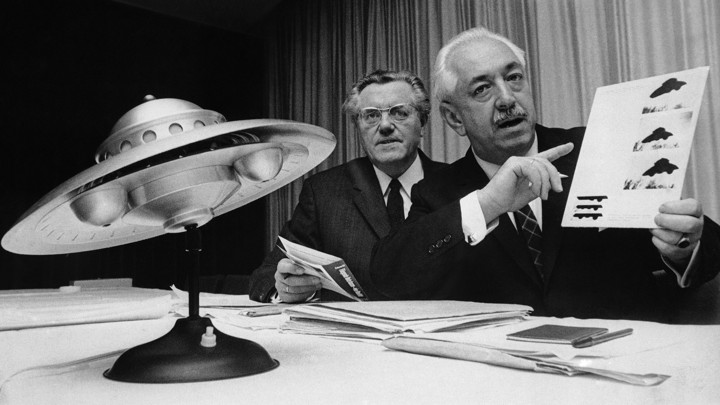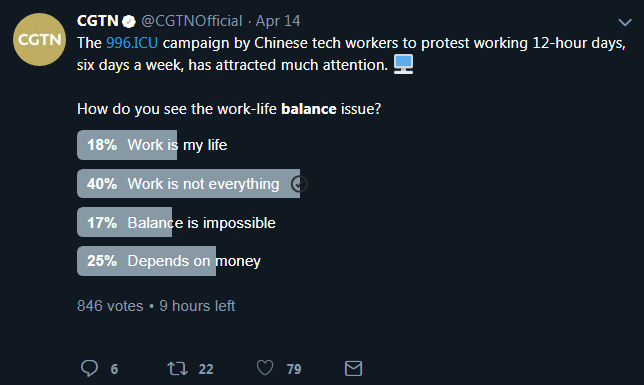Just Don’t Call Them #UFOs
The U.S. military wants pilots to report strange sightings in the sky, but doesn’t want any of the stigma that comes with it.
MARINA KOREN


KURT STRUMPF / AP
Pilots are about to receive a new memo from management: If you encounter an unidentified flying object while on the job, please tell us.
The U.S. Navy is drafting new rules for reporting such sightings, according to a recent story from Politico. Apparently, enough incidents have occurred in “various military-controlled ranges and designated airspace” in recent years to prompt military officials to establish a formal system to collect and analyze the unexplained phenomena. Members of Congress and their staffs have even started asking about the claims, and Navy officials and pilots have responded with formal briefings.
The Washington Post provided more details in its own story:
In some cases, pilots—many of whom are engineers and academy graduates—claimed to observe small spherical objects flying in formation. Others say they’ve seen white, Tic Tac–shaped vehicles. Aside from drones, all engines rely on burning fuel to generate power, but these vehicles all had no air intake, no wind and no exhaust.
The Navy knows how this sounds. It knows what you must be thinking. But the fact stands that some pilots are saying they’ve seen strange things in the sky, and that’s concerning. So the Navy is trying to assure pilots that they won’t be laughed out of the cockpit or deemed unhinged if they bring it up. “For safety and security concerns, the Navy and the [U.S. Air Force] takes these reports very seriously and investigates each and every report,” the Navy said in a statement to Politico.
Yet even as the Navy indicates it’s willing to discuss the taboo topic, it’s also shying away from three notorious little letters. UFO carries an airport’s worth of baggage, bursting with urban legends, government secrecy, and over-the-top Hollywood movies. The statements and quotes that the Navy provided to news outlets are devoid of any reference to UFOs. Instead, they’re called “unexplained aerial phenomena,” “unidentified aircraft,” “unauthorized aircraft,” and, perhaps most intriguing, “suspected incursions.”
Read: When a Harvard professor talks about aliens
The message is, if you see something, say something, but for God’s sake, lower your voice. Don’t call it a UFO. Which is funny, since the military came up with the name in the first place.
The earliest government programs dedicated to investigating UFO sightings in the late 1940s treated the claims, unsurprisingly, as a big joke. As a rule, officials dismissed and debunked any reports as hoaxes and hallucinations, according to UFOs and Government: A Historical Inquiry, a textbook-style deep dive published in 2012. This apparently didn’t sit well with some of the higher-ups.
In some ways, the Navy’s modern-day attempt to take seriously reports of UFO sightings is a rerun of what happened next. “I want an open mind,” Major General Charles Cabell, then the head of Air Force intelligence at the Pentagon, reportedly demanded at a meeting with subordinates in 1951. “Anyone who doesn’t keep an open mind can get out now.”
A new, secretive program, dubbed Project Blue Book, was quickly organized to investigate claims of strange visions in the sky without ridiculing them. Its director, Edward Ruppelt, introduced the term unidentified flying objectsometime around 1953. The definition carried no hint of extraterrestrial life; in a national-security official’s scariest daydreams, the objects were probably Russian spycraft. For the military, a UFO was simply “any airborne object which by performance, aerodynamic characteristics, or unusual features, does not conform to any presently known aircraft or missile type, or which cannot be positively identified as a familiar object.”
By then, there had already been several high-profile reports of objects flying through or falling from the sky. For the public, these sightings didn’t just seem unfamiliar—they seemed not of this world. A civilian pilot had seen nine somethings flying in formation near Mount Rainier in Washington State. A rancher found mysterious wreckage on his property outside Roswell, New Mexico. Multiple people spotted a series of lights hovering over Washington, D.C., and moving toward the White House. The military even mobilized jets to intercept them, but found nothing.
In the meantime, UFOs further infiltrated the public consciousness. They sailed into Hollywood, which to this day remains obsessed with stories about aliens, from friendly creatures to nightmarish monsters. The fourth Men in Black movie is coming out this summer, and it’s probably not the last.
Read: What UFOs mean for why people don’t trust science
Elsewhere, the lines between fiction and reality blurred. People told harrowing stories of nighttime abductions. UFOs became the focus of conspiracy theories about government secrecy. A disheveled, wild-haired man on the History Channel suggested that extraterrestrial beings helped build Stonehenge. Over time, a collective opinion emerged about those who truly believed UFOs proved the existence of aliens, and it wasn’t a flattering one. “Let’s face it—believing in the paranormal has become shorthand for crazy,” wrote Alexandra Ossola in Futurism in 2017, on the lasting stigma surrounding UFO truthers.
Military pilots are well aware of the taboo. Christopher Mellon, a former deputy assistant secretary of defense for intelligence in the Clinton and Bush administrations and an advocate for UFO study, has said service members worry that reporting UFOs puts their careers at risk. They also worry that staying silent could threaten national security, in case one of those mysterious objects turns out to be a new form of aircraft from a rival country.
“Nobody wants to be ‘the alien guy’ in the national-security bureaucracy,” Mellon wrote in a Post op-ed last year. “Nobody wants to be ridiculed or sidelined for drawing attention to the issue.”
After two decades in operation, Project Blue Book eventually concluded there was “no evidence that [UFOs] are intelligently guided spacecraft from beyond the Earth.” They attributed most sightings to, among other things, clouds, weather balloons, and even birds. “The report brushes aside the demands of some scientists and laymen for a large-scale effort to determine the nature of such ‘flying saucers,’’ The New York Times wrote in 1969. “Such a project, the report says in effect, would be a waste of time and money.”
Read: But, seriously, where are the aliens?
Future generations at the Pentagon thought differently. From 2007 to 2012, the Department of Defense operated a top-secret, $22 million program dedicated to investigating UFO reports, known as the Advanced Aerospace Threat Identification Program. The New York Times revealed its existence in a jaw-dropping story in 2017. “The program produced documents that describe sightings of aircraft that seemed to move at very high velocities with no visible signs of propulsion, or that hovered with no apparent means of lift,” the Timesreported.
Although the funding eventually ran out, officials say Defense officers continue to investigate claims reported by service members.
Edward Ruppelt probably didn’t imagine the journey his three-letter abbreviation would take over the years. In 1955, five years before he died, he dumped everything he had learned about UFOs into a nearly 300-page report. “People want to know the facts,” he wrote. “But more often than not, these facts have been obscured by secrecy and confusion, a situation that has led to wild speculation on one end of the scale and an almost dangerously blasé attitude on the other.”
As his successors in the U.S. military draft their reports and memos and guidelines, carefully avoiding any mention of that word, they will no doubt run into the same trouble he did. “The report has been difficult to write,” Ruppelt wrote in 1955, his frustration hovering above the page like the air over pavement on a hot day, “because it involves something that doesn’t officially exist.”
Pilots are about to receive a new memo from management: If you encounter an unidentified flying object while on the job, please tell us.
The U.S. Navy is drafting new rules for reporting such sightings, according to a recent story from Politico. Apparently, enough incidents have occurred in “various military-controlled ranges and designated airspace” in recent years to prompt military officials to establish a formal system to collect and analyze the unexplained phenomena. Members of Congress and their staffs have even started asking about the claims, and Navy officials and pilots have responded with formal briefings.
The Washington Post provided more details in its own story:
In some cases, pilots—many of whom are engineers and academy graduates—claimed to observe small spherical objects flying in formation. Others say they’ve seen white, Tic Tac–shaped vehicles. Aside from drones, all engines rely on burning fuel to generate power, but these vehicles all had no air intake, no wind and no exhaust.
The Navy knows how this sounds. It knows what you must be thinking. But the fact stands that some pilots are saying they’ve seen strange things in the sky, and that’s concerning. So the Navy is trying to assure pilots that they won’t be laughed out of the cockpit or deemed unhinged if they bring it up. “For safety and security concerns, the Navy and the [U.S. Air Force] takes these reports very seriously and investigates each and every report,” the Navy said in a statement to Politico.
Yet even as the Navy indicates it’s willing to discuss the taboo topic, it’s also shying away from three notorious little letters. UFO carries an airport’s worth of baggage, bursting with urban legends, government secrecy, and over-the-top Hollywood movies. The statements and quotes that the Navy provided to news outlets are devoid of any reference to UFOs. Instead, they’re called “unexplained aerial phenomena,” “unidentified aircraft,” “unauthorized aircraft,” and, perhaps most intriguing, “suspected incursions.”
Read: When a Harvard professor talks about aliens
The message is, if you see something, say something, but for God’s sake, lower your voice. Don’t call it a UFO. Which is funny, since the military came up with the name in the first place.
The earliest government programs dedicated to investigating UFO sightings in the late 1940s treated the claims, unsurprisingly, as a big joke. As a rule, officials dismissed and debunked any reports as hoaxes and hallucinations, according to UFOs and Government: A Historical Inquiry, a textbook-style deep dive published in 2012. This apparently didn’t sit well with some of the higher-ups.
In some ways, the Navy’s modern-day attempt to take seriously reports of UFO sightings is a rerun of what happened next. “I want an open mind,” Major General Charles Cabell, then the head of Air Force intelligence at the Pentagon, reportedly demanded at a meeting with subordinates in 1951. “Anyone who doesn’t keep an open mind can get out now.”
A new, secretive program, dubbed Project Blue Book, was quickly organized to investigate claims of strange visions in the sky without ridiculing them. Its director, Edward Ruppelt, introduced the term unidentified flying objectsometime around 1953. The definition carried no hint of extraterrestrial life; in a national-security official’s scariest daydreams, the objects were probably Russian spycraft. For the military, a UFO was simply “any airborne object which by performance, aerodynamic characteristics, or unusual features, does not conform to any presently known aircraft or missile type, or which cannot be positively identified as a familiar object.”
By then, there had already been several high-profile reports of objects flying through or falling from the sky. For the public, these sightings didn’t just seem unfamiliar—they seemed not of this world. A civilian pilot had seen nine somethings flying in formation near Mount Rainier in Washington State. A rancher found mysterious wreckage on his property outside Roswell, New Mexico. Multiple people spotted a series of lights hovering over Washington, D.C., and moving toward the White House. The military even mobilized jets to intercept them, but found nothing.
In the meantime, UFOs further infiltrated the public consciousness. They sailed into Hollywood, which to this day remains obsessed with stories about aliens, from friendly creatures to nightmarish monsters. The fourth Men in Black movie is coming out this summer, and it’s probably not the last.
Read: What UFOs mean for why people don’t trust science
Elsewhere, the lines between fiction and reality blurred. People told harrowing stories of nighttime abductions. UFOs became the focus of conspiracy theories about government secrecy. A disheveled, wild-haired man on the History Channel suggested that extraterrestrial beings helped build Stonehenge. Over time, a collective opinion emerged about those who truly believed UFOs proved the existence of aliens, and it wasn’t a flattering one. “Let’s face it—believing in the paranormal has become shorthand for crazy,” wrote Alexandra Ossola in Futurism in 2017, on the lasting stigma surrounding UFO truthers.
Military pilots are well aware of the taboo. Christopher Mellon, a former deputy assistant secretary of defense for intelligence in the Clinton and Bush administrations and an advocate for UFO study, has said service members worry that reporting UFOs puts their careers at risk. They also worry that staying silent could threaten national security, in case one of those mysterious objects turns out to be a new form of aircraft from a rival country.
“Nobody wants to be ‘the alien guy’ in the national-security bureaucracy,” Mellon wrote in a Post op-ed last year. “Nobody wants to be ridiculed or sidelined for drawing attention to the issue.”
After two decades in operation, Project Blue Book eventually concluded there was “no evidence that [UFOs] are intelligently guided spacecraft from beyond the Earth.” They attributed most sightings to, among other things, clouds, weather balloons, and even birds. “The report brushes aside the demands of some scientists and laymen for a large-scale effort to determine the nature of such ‘flying saucers,’’ The New York Times wrote in 1969. “Such a project, the report says in effect, would be a waste of time and money.”
Read: But, seriously, where are the aliens?
Future generations at the Pentagon thought differently. From 2007 to 2012, the Department of Defense operated a top-secret, $22 million program dedicated to investigating UFO reports, known as the Advanced Aerospace Threat Identification Program. The New York Times revealed its existence in a jaw-dropping story in 2017. “The program produced documents that describe sightings of aircraft that seemed to move at very high velocities with no visible signs of propulsion, or that hovered with no apparent means of lift,” the Timesreported.
Although the funding eventually ran out, officials say Defense officers continue to investigate claims reported by service members.
Edward Ruppelt probably didn’t imagine the journey his three-letter abbreviation would take over the years. In 1955, five years before he died, he dumped everything he had learned about UFOs into a nearly 300-page report. “People want to know the facts,” he wrote. “But more often than not, these facts have been obscured by secrecy and confusion, a situation that has led to wild speculation on one end of the scale and an almost dangerously blasé attitude on the other.”
As his successors in the U.S. military draft their reports and memos and guidelines, carefully avoiding any mention of that word, they will no doubt run into the same trouble he did. “The report has been difficult to write,” Ruppelt wrote in 1955, his frustration hovering above the page like the air over pavement on a hot day, “because it involves something that doesn’t officially exist.”
THE U.S. NAVY'S DECISION TO CREATE NEW GUIDELINES FOR REPORTING UAPS, UNIDENTIFIED AERIAL PHENOMENA, SIGNALS THAT THEY MIGHT BE TAKING THIS MATTER MORE SERIOUSLY.
By Marcia Wendorf April, 27th 2019
Pixabay
A story published on April 23, 2019, on the website of POLITICO, described new guidelines set out by the U.S. Navy for its pilots and other personnel to report Unidentified Aerial Phenomenon (UAPs), which is what is called UFOs, or Unidentified Flying Objects in popular culture.
The Navy told POLITICO, "There have been a number of reports of unauthorized and/or unidentified aircraft entering various military-controlled ranges and designated air space in recent years."
"The Navy is updating and formalizing the process by which reports of any such suspected incursions can be made to the cognizant authorities. A new message to the fleet that will detail the steps for reporting is in draft."
A UAP and F/A-18 Super Hornet fighter jets play cat and mouse
In late 2017, both POLITICO and the New York Times reported on an office that had been set up within the Defense Intelligence Agency to study UAPs. It was called the Advanced Aerospace Threat Identification Program, and was run by a man named Luis Elizondo. During that reporting, the puzzling 2004 case of the USS Nimitz Carrier Strike Group came to light.
The carrier group, which was operating off the coast of San Diego, California, had for two weeks been tracking UAPs. One day, it got lucky when it happened to have three F/A-18 Super Hornet fighter jets up in the sky just when the UAPs showed up.
The three fighters caught up with a UAP as it was hovering mere inches above the ocean surface, and churning up a considerable amount of water.
Catching sight of the fighter jets, the UAP rose almost instantaneously to a height of 12,000 feet, where it and the fighters began a game of cat and mouse. Luckily, it was all caught on video by Raytheon Corporation's Advanced Targeting Forward Look Infrared (ATFLIR) sensor on one of the jets:
Last year, Commander David Fravor, the pilot whose voice can be heard on the above video, appeared on Fox News where he described the encounter. When asked where he thought the craft came from, Fravor said that it was, "something not from this world."
November in Chicago is cold and cloudy but apparently, not boring
On the afternoon of November 7, 2006 at Chicago's O'Hare airport, a United Airlines employee was pushing United Airlines Flight 446 back from the gate when he looked up and saw a metallic, saucer-shaped craft hovering above.
The man radioed Flight 446's flight crew who also saw the craft. Eventually, twelve airport employees were observing the craft, as well as witnesses from outside the airport.
Apparently, having seen their fill, if you've ever been to Chicago in November, or been to O'Hare Airport, you know what I mean, the craft shot upwards through the clouds at such a high rate of speed that it left a clear blue hole in the cloud layer.
Initially, both United Airlines and the Federal Aviation Administration (FAA) denied the existence of the sighting, until the Chicago Tribune newspaper filed a Freedom of Information Act (FOIA) request. That unearthed a call made by a United Airlines supervisor to an FAA manager in the airport tower concerning the UAP.
March in Phoenix is much more pleasant than November in Chicago
On the night of March 13, 1997, a man in Henderson, Nevada reported seeing a huge V-shaped object with six lights that was heading toward Arizona.
In Paulden, Arizona, a former police officer saw a V-shaped cluster of reddish or orange lights overhead. He watched until the lights disappeared over the horizon. Next, the police switchboard in Prescott, Arizona lit up with callers reporting a V-shaped cluster of lights flying overhead.
Prescott resident Tim Ley and his wife Bobbi observed the craft pass directly over their heads, before it began heading straight for Phoenix. Witnesses in Glendale, a suburb of Phoenix, watched the object pass directly over them, while in Phoenix, truck driver Bill Greiner observed the lights and said, "Before this, if anybody had told me they saw a UFO, I would've said, 'Yeah and I believe in the Tooth Fairy.' Now I've got a whole new view, and I may be just a dumb truck driver, but I've seen something that don't belong here."
Also observing the lights in Phoenix was a former Air Force pilot named Fife Symington.
As a former pilot, Symington knew the lights were unusual, and his observation would carry a little more weight since, at that time, he was Arizona's governor. Symington went on to say, "I'm a pilot and I know just about every machine that flies. It was bigger than anything that I've ever seen. It remains a great mystery."
In response to the U.S. Air Force's claims that the lights were flares, Symington responded. "... it couldn't have been flares because it was too symmetrical. It had a geometric outline, a constant shape."
My personal experience
Early one morning, I took our dog outside to do his business. Everything was quiet in the rolling hills outside a western U.S. city. I was standing facing due south and not paying attention to much of anything, when the rays of the sun rising to my left struck something in the sky, and reflected back down to me. Looking up, I saw an oval-shaped craft hovering motionless in the sky.
At first, I thought it was an airplane flying at such an angle to me that it appeared stationary, but then I recognized it for what it was. While the dog nosed along the ground, both the craft and I remained motionless for several minutes. Then, at a dizzying speed, the craft made two zig-zags in the sky, drawing a "W" open to the east, and it came to rest more directly overhead.
Are we alone in the Universe?
That afternoon, I reported my experience to MUFON, the Mutual UFO Network. MUFON is the oldest and largest civilian UFO investigation and research organization in the world. Their stated goal is to answer the age old question: "Are we alone in the universe?"
MUFON (Mutual UFO Network) was started in 1969 by groups located in Missouri, Iowa, Illinois, Wisconsin, Michigan, and Minnesota, and the "M" originally stood for Midwest. MUFON began cooperating with the Center for UFO Studies located at Northwestern University, and run by former Project Blue Book director Dr. Allen Hynek.
By 1971, MUFON had developed a Field Investigator's Manual, and in the late 2000s, it developed a computerized Case Management System (CMS), which allows anyone to report a UFO incident anywhere in the world. Currently, the case management system contains over 80,000 entries.
Click the "News" tab on MUFON's website, and you can read dozens of recent UAP cases reported by ordinary citizens. They are chilling in their "ordinariness". Currently, MUFON has a membership of over 4,000, publishes an online journal, and has trained more than 500 field investigators. On July 26 - 28, 2019, at the Hotel Irvine, Irvine California, MUFON will host its annual symposium. Scheduled presenters include Stanton Friedman. (CANADIAN UFOLOGIST)
In May 2019, the History Channel is starting a six-part series on the UAP phenomenon that will be presented by Luis Elizondo., the former director of the Advanced Aerospace Threat Identification Program. It comes on the heels of another show that aired on the History Channel entitled, "Project Blue Book."
Weekend Picks














 @GameWorkers
@GameWorkers








